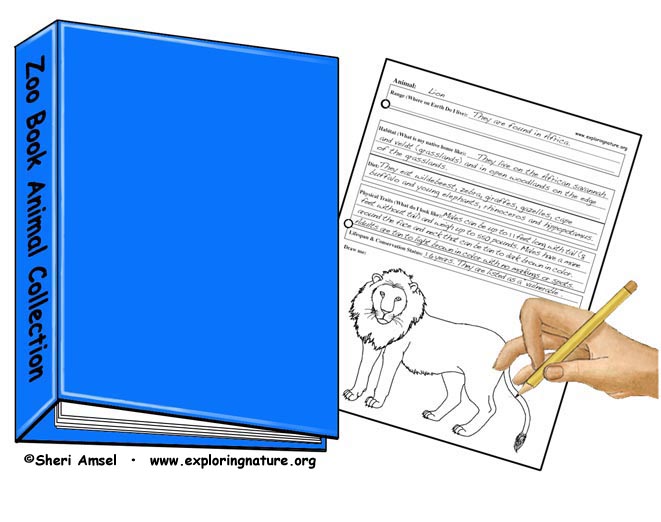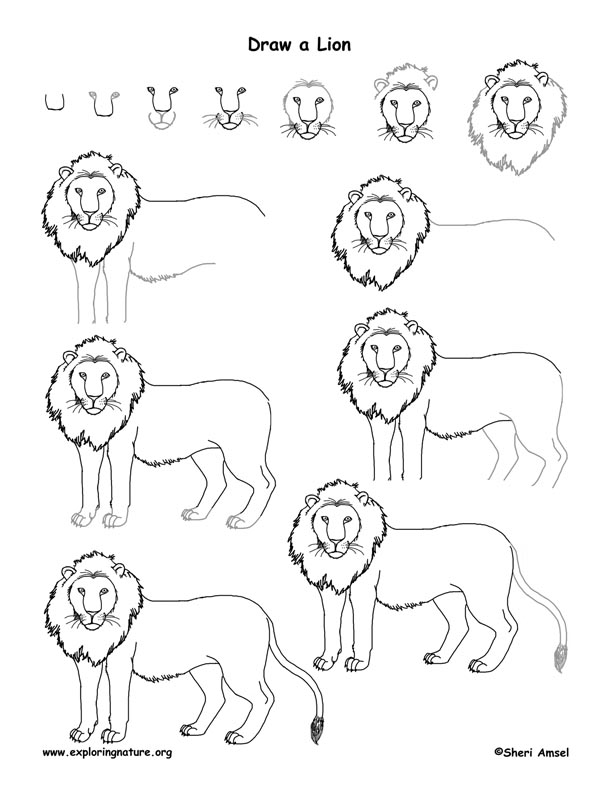

Before you go to the zoo, learn about the animals you will see in the zoo exhibits. Using the links below discover each animal's range, habitat, diet, body traits, lifespan and conservation status. Think about its role in its habitat and food web.
Choose 10 of your favorite animals and using the zoo animal graphic organizer, put together a "Zoo Book Animal Collection". Use the animal drawing or coloring links to illustrate your zoo book.
Choose a specific habitat exhbited at the zoo and using the animals you have researched, create a food web for that ecosystem. Use the food web resources on Exploring Nature to help fill out the species in your food webs.
Here are some exhibits specific to the Denver Zoo*, though these species are common at zoos worldwide:
In the Toyota Elephant Passage, see the Asian elephants, and Malayan tapirs, and clouded leopards.
Learn to draw the elephants and tapirs.
At Benson Predator Ridge, see the African lions and spotted hyenas.
Learn to draw lions and hyenas.
See giraffes in the Giraffe Encounter and learn to draw them.
In the Primate Panorama, see the orangutans, gorillas, and aye-ayes.
Learn to draw the gorilla.
Print out and color the orangutan and aye-aye.
In Tropical Discovery Exhibit, see the Komodo dragon, blue poison dart frog and clown fish.
Print out and color and color a Komodo here.
In the Northern Shores Exhibit, see the polar bear, harbor seal and arctic fox.
Learn to draw the polar bear.
Print out and color the harbor seal.
In the Birds Exhibit, see the flamingos, scarlet macaws, toucans, bald eagles and cassowary.
Learn to draw a flamingo, macaw, toucan and bald eagle.
Print out and color the cassowary.
At the Bear Mountain Exhibit, see the grizzly bears, black bears and coati.
Learn to draw the black bear.
Print out and color the grizzly and coati.
See the hippos and black rhino at the Pachyderm Exhibit.
Learn to draw the hippo and the rhino.
In the Felines Exhibit, see the tigers and snow leopard.
Learn to draw the tiger.
Print out and color the snow leopard.
Other animals you might see at the Denver Zoo are the bighorn sheep, red panda, okapi, zebra, warthog, dromedary camel, kangaroo, California Sea lion, ring-tailed lemur, river otter, capybara, frilled lizard, giraffe, emu, peacock, and cheetah.
Learn to draw the okapi, zebra, otter, capybara, giraffe, peacock and cheetah.
Print out and color the ring-tailed lemur, camel, kangaroo, and warthog.
* The Denver Zoo is located at: 2300 Steele Street, Denver, CO 80205-4899
Here is an example a completed lion Zoo Animal Graphic Organizer Page and a lion Drawing Activity:
Disciplinary Core Ideas:
LS1.A: Structure and Function
• Plants and animals have both internal and external structures that serve various functions in growth, survival, behavior, and reproduction. (4-LS1-1)
LS2.A: Interdependent Relationships in Ecosystems
• There are many different kinds of living things in any area, and they exist in different places on land and in water. (2-LS4-1)
• The food of almost any kind of animal can be traced back to plants. Organisms are related in food webs in which some animals eat plants for food and other animals eat the animals that eat plants.
• Organisms, and populations of organisms, are dependent on their environmental interactions both with other living things and with nonliving factors. (MS-LS2-1)
LS2.C: Ecosystem Dynamics, Functioning, and Resilience
• Ecosystems are dynamic in nature; their characteristics can vary over time. Disruptions to any physical or biological component of an ecosystem can lead to shifts in all its populations. (MS-LS2-4)
• Biodiversity describes the variety of species found in Earth’s terrestrial and oceanic ecosystems. The completeness or integrity of an ecosystem’s biodiversity is often used as a measure of its health. (MS-LS2-5)
LS2.D: Social Interactions and Group Behavior
• Being part of a group helps animals obtain food, defend themselves, and cope with changes. Groups may serve different functions and vary dramatically in size (Note: Moved from K–2). (3-LS2-1)
LS4.D: Biodiversity and Humans
2-LS4-1.P Make observations of plants and animals to compare the diversity of life in different habitats.
Performance Expectations:
2-LS2-1. Make observations of plants and animals to compare the diversity of life in different habitats.[Clarification Statement: Emphasis is on the diversity of living things in each of a variety of different habitats.] [Assessment Boundary: Assessment does not include specific animal and plant names in specific habitats.]
4-LS1-1. Construct an argument that plants and animals have internal and external structures that function to support survival, growth, behavior, and reproduction. [Clarification Statement: Examples of structures could include thorns, stems, roots, colored petals, heart, stomach, lung, brain, and skin.] [Assessment Boundary: Assessment is limited to macroscopic structures within plant and animal systems.]
4-LS1-2. Use a model to describe that animals receive different types of information through their senses, process the information in their brain, and respond to the information in different ways. [Clarification Statement: Emphasis is on systems of information transfer.] [Assessment Boundary: Assessment does not include the mechanisms by which the brain stores and recalls information or the mechanisms of how sensory receptors function.]
ETS1.B: Developing Possible Solutions
• Designs can be conveyed through sketches, drawings, or physical models. These representations are useful in communicating ideas for a problem’s solutions to other people. (secondary to 2-LS2-2)
Common Core State Standards Connections:
ELA/Literacy
W.2.7 Participate in shared research and writing projects (e.g., read a number of books on a single topic to produce a report; record science observations). (2-LS4-1)
W.2.8 Recall information from experiences or gather information from provided sources to answer a question. (2-LS4-1)RI.3.1 Ask and answer questions to demonstrate understanding of a text, referring explicitly to the text as the basis for the answers. (3-LS2-1)
RI.5.7 Draw on information from multiple print or digital sources, demonstrating the ability to locate an answer to a question quickly or to solve a problem efficiently. (5-LS2-1)
SL.4.5 Add audio recordings and visual displays to presentations when appropriate to enhance the development of main ideas or themes. (4-LS1-2)
SL.5.5 Include multimedia components (e.g., graphics, sound) and visual displays in presentations when appropriate to enhance the development of main ideas or themes. (5-LS2-1)
When you research information you must cite the reference. Citing for websites is different from citing from books, magazines and periodicals. The style of citing shown here is from the MLA Style Citations (Modern Language Association).
When citing a WEBSITE the general format is as follows.
Author Last Name, First Name(s). "Title: Subtitle of Part of Web Page, if appropriate." Title: Subtitle: Section of Page if appropriate. Sponsoring/Publishing Agency, If Given. Additional significant descriptive information. Date of Electronic Publication or other Date, such as Last Updated. Day Month Year of access < URL >.
Amsel, Sheri. "Zoo Book Activity - Before You Go to The Denver Zoo" Exploring Nature Educational Resource ©2005-2024. December 15, 2024
< http://www.exploringnature.org/db/view/Zoo-Book-Activity-Before-You-Go-to-The-Denver-Zoo >



